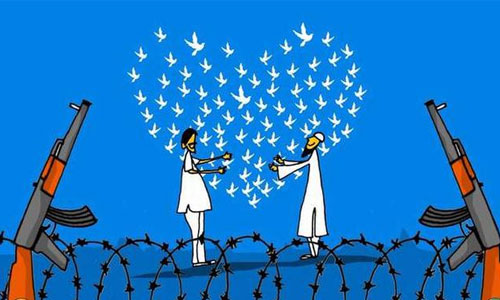The 1979 Russian invasion of Afghanistan inflicted political instability and crises on the country. People were internally displaced and large numbers fled the country. The fall of the Soviet Union in 1989 was coupled with civil wars in Afghanistan which paved the way for Taliban’s Islamic Emirates to take over. After nearly four decades, Afghanistan still suffers from armed conflict mainly spearheaded by the Taliban. The 1990s civil wars, the rise and fall of the Taliban and post 9/11 America’s operation in Afghanistan need to be analyzed when we evaluate peace talks between the National Unity Government (NUG) and the Taliban. This article highlights the paradoxes of peace talks with the Taliban by setting the spotlight on. It further indicates the role of regional states, their relationships with and supports of the Taliban.
Hamid Karzai, former president of Afghanistan, established the High Peace Council (HPC) in 2010 in order to facilitate direct peace talks with moderate elements of the Taliban group. The HPC contacting the different elements within the Taliban groups which were characterized as the Afghan Taliban. The efforts made by Hamid Karzai’s administration ended with the establishment of Taliban’s office in Qatar, aiming to initiate direct negotiation with the so called Afghan Taliban. The government side withdrew from the direct talks with groups after the Taliban office in Qatar posed as the Islamic Emirates Embassy with white flag. In July 2015, Mullah Mohammad Omar, the leader of the group backed the peace talks with Afghanistan government and called negotiation as the legitimate way of ending foreign invasion in Afghanistan. In August, 2015 Afghanistan’s National Security Directorate formally confirmed the death of Mullah Omar, the Taliban announced Mullah Mansoor as his successors. The Taliban disavowed the peace talks after their leader’s death. Although in post 2014, the NUG has tried to bring the Taliban to the negotiation table and create global, regional and national consensus for the peace process in Afghanistan, it failed to generate any substantial results. The Taliban carried their violence destruction by constantly attacking city centers and highways.
In 2015, the Taliban captured the capital city of Kunduz a strategic northern province, for the first time since they were removed from power in 2001.They overrun Kunduz once again in 2016. Recently, in august 2018 they coordinated a heavy attack on the strategic province of Ghazni. These events show that the Taliban are least interested in peace talks and negotiation. The group rejects ceasefire with Afghanistan government and instead insists on having direct talks with the United States.
There are complex paradoxes of the peace process in Afghanistan which undermines the success of the process.
First, many Afghan officials emphasize that the Taliban is not an independent armed group capable of negotiating with the Afghan state. They are supported by different regional countries mainly Pakistan and Iran; both main players in fueling war in Afghanistan. In 2016, the group leader Mullah Mansoor visited Iran and while crossing the border to Pakistan was killed by the U.S drone strike. Iran support for the Taliban could be rationalized by three main reasons, countering ISIS Khurasan, complicating the U.S longest war and having control over water resources of Afghanistan. According to reports Iran provides the Taliban with Ak-47 assault rifles and facilitating cash transfers in near border areas. In August, 2018, Mullah Abdul Ghaffar Tufan, a Taliban leader who surrendered earlier accused Iran, Russia and China for providing assistance to the group and ask them to destroy school, mosques, roads and do not allow development projects to take place in Afghanistan. However, China’s support for the Taliban is hard to be proven.
Second Pakistan’s political and strategic support goes back to the rise of Taliban during the 1990s civil wars in Afghanistan. Pakistan created the Taliban with the supports from the gulf region. Intern-intelligence Service (ISI) trained Taliban’s fighters which overthrew the Mujahidin government in 1996. According to Peter Thomsen, the former US Envoy to Afghanistan Islamabad still uses the Taliban to further its interest in the region. Ministry of Interior Affair’s spokesperson claimed that Pakistan’s Military were involved in the coordinated attack on Ghazni in last August; it provided all the needed assistance to the Taliban. Since 2014 several high level visits have taken place between Afghanistan to Pakistan without resulting to any clear end.
The past experiences indicate that negotiation may take place between the government and the Taliban group. But, making happy all the players in this multi-dimensional conflict will be very time consuming, which puts the past achievements of Afghanistan in to jeopardy. Achieving sustainable peace in Afghanistan is complicated, which needs strong national government, national, regional and global consensus coupled with defeating the Taliban, in the battlefield and employing a sustainable working multi-dimensional foreign policy.
Home » Opinion » Paradoxes of Peace Talks in Afghanistan
Paradoxes of Peace Talks in Afghanistan
| Abass Azimi

